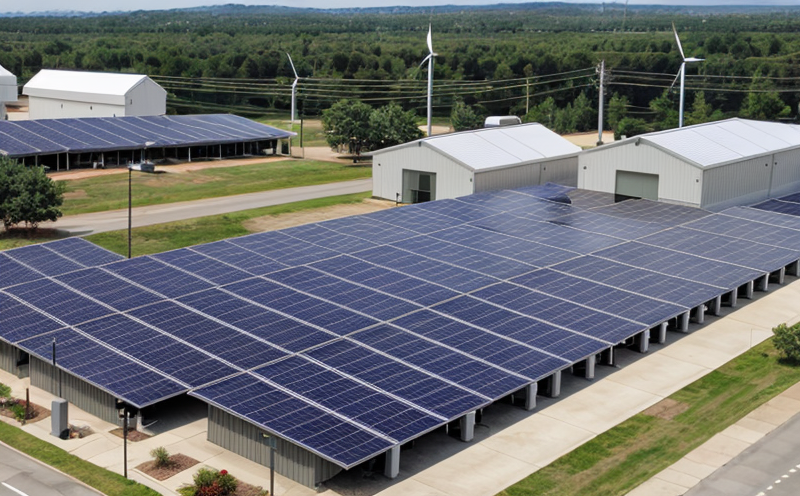UL 9540A Thermal Runaway Fire Propagation Testing in Microgrids
The UL 9540A standard is a critical tool for ensuring the safety of microgrid systems, which are becoming increasingly important as the world transitions to more sustainable energy solutions. The test protocol outlined in this standard evaluates the potential for thermal runaway and fire propagation within these complex systems. This service ensures that components and systems meet strict fire-safety criteria, thereby protecting not only equipment but also personnel and the environment.
Microgrids are localized networks that can operate independently or in conjunction with traditional power grids. They often incorporate renewable energy sources like solar panels, wind turbines, and energy storage systems. The integration of these components introduces new challenges related to fire safety, as they may generate heat during operation. UL 9540A addresses this by providing a method for assessing the risk of thermal runaway and subsequent fire propagation within microgrid configurations.
The test procedure involves simulating an initial fault condition that could lead to overheating or electrical breakdown in key components such as inverters, transformers, circuit breakers, and other essential equipment. The objective is to determine whether these elements can contain any resulting thermal runaway without causing a fire that spreads to nearby components or the entire microgrid structure.
The testing process typically begins with thorough preparation of the sample system according to specified standards. This includes connecting all relevant parts in their intended configuration, ensuring proper grounding and isolation, and verifying that all safety interlocks are functioning correctly. Once the setup is complete, the test engineer initiates the fault condition under controlled conditions.
The instrumentation used during testing often includes advanced thermal cameras capable of detecting extremely small temperature changes indicative of early signs of overheating or incipient fires. Data loggers record detailed information about voltage, current, temperatures at various points in the system, and other relevant parameters throughout the test duration. This data is crucial for evaluating the performance of individual components under fault conditions.
After completing the test sequence, engineers analyze the collected data to assess whether any component exhibited signs of thermal runaway or fire propagation. If no such issues were observed, the system passes the UL 9540A requirement. However, if problems are identified, adjustments may be necessary before retesting can occur.
| Test Parameter | Description |
|---|---|
| Initial Fault Condition | A predefined scenario designed to simulate conditions likely to cause overheating or electrical breakdown. |
| Data Collection Equipment | Instruments like thermal cameras and data loggers used to monitor temperature changes, current flow, etc. |
| Sample System Preparation | The assembly of the microgrid components in accordance with specific standards prior to testing. |
| Test Duration | The total time required for completing all test sequences and post-test evaluations. |
Scope and Methodology
The scope of UL 9540A Thermal Runaway Fire Propagation Testing encompasses a wide range of microgrid components, including inverters, transformers, circuit breakers, and energy storage systems. These devices must be evaluated for their ability to contain any thermal runaway events within the confines of the system itself without causing hazardous fires.
- Components: Inverters, transformers, circuit breakers, batteries
- Conditions: Initial fault conditions designed to simulate real-world scenarios
- Data Collection: Continuous monitoring using thermal cameras and data loggers
- Evaluations: Post-test analysis of temperature changes, current flow, etc.
The methodology involves setting up the microgrid in a controlled environment where it can be subjected to various fault conditions. Each component is tested individually or as part of an integrated system to ensure that they do not contribute to fire propagation when subjected to these conditions. The use of advanced instrumentation ensures precise measurement and accurate reporting.
Eurolab Advantages
At Eurolab, we pride ourselves on providing comprehensive testing services that go beyond compliance with regulatory requirements. Our experienced team of engineers specializes in microgrid systems and understands the unique challenges associated with ensuring fire safety in these complex networks. Here are some key advantages:
- Expertise and Experience: Our staff has extensive experience working with microgrids and renewable energy technologies.
- State-of-the-Art Facilities: We operate cutting-edge laboratories equipped with the latest testing equipment to ensure accurate results.
- Comprehensive Reporting: Detailed reports are provided, offering insights into test performance and areas for improvement.
Use Cases and Application Examples
The UL 9540A testing protocol is particularly valuable in several scenarios where microgrids are deployed:
- Solar Farm Integration: Ensuring that the integration of solar panels into a grid does not pose fire risks.
- Energy Storage Systems: Evaluating battery systems to prevent thermal runaway from spreading to other parts of the microgrid.
- Retrofitting Existing Microgrids: Testing older systems to verify compliance with current safety standards.
The following table summarizes some common applications:
| Application Scenario | Purpose of Testing |
|---|---|
| Solar Farm Integration | Ensure safe operation alongside existing grid infrastructure. |
| Energy Storage Systems | Evaluate battery systems for containment of thermal runaway events. |
| Retrofitting Existing Microgrids | Verify compliance with current safety standards after modifications or upgrades. |





